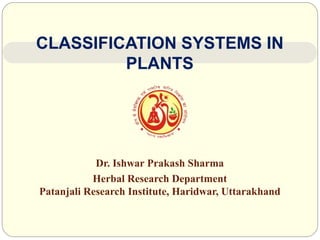
CLASSIFICATION SYSTEMS IN PLANTS
- 1. Dr. Ishwar Prakash Sharma Herbal Research Department Patanjali Research Institute, Haridwar, Uttarakhand CLASSIFICATION SYSTEMS IN PLANTS
- 2. Plant Systematics Plant systematics is the branch of botany that is concerned with the- I- Identification N- Naming D- Description C- Classification Classification of plants is a very ancient topics. First plant classification reported in Vedas around 2000 BC. Classification means the divination of something by the basis of some properties.
- 3. Objectives of Taxonomy o Determining what is a species (or their sub-divisions, as subspecies) o Distinguishing these species from others through keys and descriptions and geographic boundaries and mapping their distributions o Investigating their interrelationships, and o Determining proper names of species and higher order ranks using international rules of nomenclature. o In addition, some taxonomists investigate processes of evolution that lead to the existing pattern of species and their interrelationships.
- 4. Around 400000 plant species are reported in the world now (Stearn, 1980) The World Conservation Union’s (IUCN) Red List of Plants included some 34,000 threatened species in 1997. 60,000 to 100,000 plant species are currently threatened 75% of the world’s population relies on traditional medicines. Globally, 80% of our plant based calorie intake comes from just 12 domesticated plant species (8 cereals,4 tubers) though 30,000 species of plant are edible. Why Classification?
- 6. Oldest and first approach of classification of plants Can not describe all plants Classification of plants into different taxa based upon one or few characteristics of plants which is selected by authors. Such as- Reproductive behavior Physical appearances Habitat Cotyledon etc. Artificial classification
- 7. 1. Vedas ( ar. 200 BC.) 2. Theophrastus ( 370-285 BC.) 3. Secundus (23-79 AD.) 4. Dioscorides (62-128 AD.) 5. Magnus (1200-1280 AD.) 6. Brunfels ( 1464-1553 AD.) 7. Bock (1489-1554 AD.) 8. Fuchs ( 1501- 1556 AD.) 9. Tournefort (1656-1708 AD.) 10. Linnaeus (1707-1778 AD.) Some important artificial system
- 8. Basis of some artificial classification system
- 9. 1. Monandria: (1 stamen) 2. Diandria: (2 stamens) 3. Triandria: (3 stamens) 4. Tetrandria: (4 stamens) 5. Pentandria: (5 stamens) 6. Hexandria: (6 stamens) 7. Heptandria: (7 stamens) 8. Octandria: (8 stamens) 9. Enneandria: (9 stamens) 10. Decandria: (10 stamens) 11. Dodecandria: (12 stamens) 12. Icosandria: (20 or more stamens) 13. Polyandria: (many stamens) 14. Didynamia: (4 stamens, 2 long and 2 short) 15. Tetradynamia: (6 stamens, 4 long and 2 short) 16. Monadelphia: (Stamens monadelphous) 17. Diadelphia: (Stamens diadelphous) 18. Polyadelphia: (Stamens polyadelphous) 19. Syngenesia: (Stamens synantherous) 20. Gynandria: (Stamens connate to gynoecium) 21. Monoecia: (monoecious plant) 22. Dioecia: (Dioecious plants) 23. Polygamia: (Polygamous plants) 24. Cryptogamia: Plant without flowers Linnious system of classification
- 10. Advantages Simple and easy Need short time and information Poorly known plant can be placed easily Need very few instruments Specifically focus on properties of interest Disadvantages Can not grouped all plant perfectly Little predictive value Arbitrarily selected properties do not necessarily correlate well with each other Cannot describe evolution Advantages and disadvantages of Artificial classification
- 11. This taxonomic system was introduced by Jean Bauhin in 1623. These systems are based on natural affinities of plants. It is done based on natural characteristics of plant. It place together organisms that have the greatest number of shared features. No single feature is not important but total features are the tools of classification. Natural Classification
- 12. 1. Gaspard Bauhin (1550-1624) 2. Ray ( 1627-1 705AD.) 3. Adanson (1727-1806) 4. A. L. de Jussieu ( 1748-1836) 5. Robert Brown ( 1773-1858) 6. A.P. Candole (1778-1884) 7. Alphonse (1806-1893) 8. Benthum ( 1800-1884) and Hooker (1817-1911) Some Important Natural Classification System
- 13. Basis of some Natural classification system
- 14. Bentham & Hooker System of Classification
- 15. Advantages More satisfactory on placing of species More predictive value Arbitrarily selected properties are necessarily correlate well with each other can be used to predict properties, not related the classification Contains more information about a species Disadvantages Complex than artificial Need long time and more information Poorly known plant can not be placed easily Can not focus specifically on properties of interest Advantages and disadvantages of Natural classification
- 16. Latest system of classification of life. Done in very micro scale (cells) Basic of the system is the Darwin's “Origin of Species (1859)” First introduced by August Wilhelm Eichler in 1883. Goal of the system is to establish a system of classification based on the course of evolutionary descent of its members. System where it is believed that every species is come from the evolutionary change. Phylogenetic Classification
- 17. 1. Eichler (1839-1889) 2. Engler (1844-1930) 3. Prantl (1849-1893) 4. Bessey (1845-1915) 5. Sokal & Sneath (1963,73) 6. Hutchinson (1884-1972) 7. Takhtajan (1980) 8. Cronquist (1981) 9. Dahlgren (1981) 10. Thorne (1981) 11. APG (Angiosperm Phylogeny Group system) Some Important Natural Classification System
- 18. Advantages unique name for each species eliminates confusion Maximum predictive value Maximum detail scientific study Contains maximum information about a species Disadvantages Most Complex than others Need long time and research Physical appearances are neglected Physically same species can be in different groups Advantages and Disadvantages of Phylogenetic Classification
- 19. Arificial classification Theophrastus ca. 300 B.C. Linnaeus (1707-1778 AD.) Natural classification Benthum ( 1800-1884) and Hooker (1817-1911) Phylogenetic classification Hutchinson (1884-1972) Takhtajan (1980) APG (Angiosperm Phylogeny Group system) Most Widely Accepted Systems
- 20. Now Phylogenetic and natural classification system is combined to classification of plants Modern Classification System
- 21. Historical Development of Plant Taxonomic System